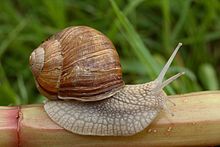Burgundy snail
| Helix pomatia | |
|---|---|
 |
|
| Scientific classification | |
| Kingdom: | Animalia |
| Phylum: | Mollusca |
| Class: | Gastropoda |
| (unranked): | clade Heterobranchia clade Euthyneura clade Panpulmonata clade Eupulmonata clade Stylommatophora informal group Sigmurethra |
| Superfamily: | Helicoidea |
| Family: | Helicidae |
| Subfamily: | Helicinae |
| Tribe: | Helicini |
| Genus: | Helix |
| Species: | H. pomatia |
| Binomial name | |
|
Helix pomatia Linnaeus, 1758 |
|
Helix pomatia, common names the Roman snail, Burgundy snail, edible snail or escargot, is a species of large, edible, air-breathing land snail, a terrestrial pulmonate gastropod mollusk in the family Helicidae. It is a European species. In the English language it is called by the French name escargot when used in cooking (escargot simply means 'snail'). Although this species is highly prized as a food it is difficult to cultivate and rarely farmed commercially.
Distribution of Helix pomatia includes:
Southeastern and central Europe:
Western Europe:
Eastern Europe:
southern Europe:
The shell is creamy white to light brownish, often with indistinct brown colour bands. The shell has five to six whorls. The aperture is large. The apertural margin is white and slightly reflected in adult snails. The umbilicus is narrow and partly covered by the reflected columellar margin.
The width of the shell is 30–50 mm. The height of the shell is 30–45 mm.
In southeastern Europe, H. pomatia lives in forests, open habitats, gardens, vineyards, especially along rivers, confined to calcareous substrate. In central Europe, it occurs in open forests and shrubland on calcareous substrate. It prefers high humidity and lower temperatures, and needs loose soil for burrowing to hibernate and lay its eggs. It lives up to 2100 m above sea level in the Alps, but usually below 2000 m. In the south of England, it is restricted to undisturbed grassy or bushy wastelands, usually not in gardens; it has a low reproduction rate and low powers of dispersal.
Average distance of migration reaches 3.5–6.0 m.
This snail is hermaphroditic. Reproduction in central Europe begins at the end of May.
...
Wikipedia

